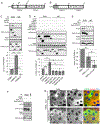The ability of the LIMD1 and TRIP6 LIM domains to bind strained f-actin is critical for their tension dependent localization to adherens junctions and association with the Hippo pathway kinase LATS1
- PMID: 38426816
- PMCID: PMC11366040
- DOI: 10.1002/cm.21847
The ability of the LIMD1 and TRIP6 LIM domains to bind strained f-actin is critical for their tension dependent localization to adherens junctions and association with the Hippo pathway kinase LATS1
Abstract
A key step in regulation of Hippo pathway signaling in response to mechanical tension is recruitment of the LIM domain proteins TRIP6 and LIMD1 to adherens junctions. Mechanical tension also triggers TRIP6 and LIMD1 to bind and inhibit the Hippo pathway kinase LATS1. How TRIP6 and LIMD1 are recruited to adherens junctions in response to tension is not clear, but previous studies suggested that they could be regulated by the known mechanosensory proteins α-catenin and vinculin at adherens junctions. We found that the three LIM domains of TRIP6 and LIMD1 are necessary and sufficient for tension-dependent localization to adherens junctions. The LIM domains of TRIP6, LIMD1, and certain other LIM domain proteins have been shown to bind to actin networks under strain/tension. Consistent with this, we show that TRIP6 and LIMD1 colocalize with the ends of actin fibers at adherens junctions. Point mutations in a key conserved residue in each LIM domain that are predicted to impair binding to f-actin under strain inhibits TRIP6 and LIMD1 localization to adherens junctions and their ability to bind to and recruit LATS1 to adherens junctions. Together these results show that the ability of TRIP6 and LIMD1 to bind to strained actin underlies their ability to localize to adherens junctions and regulate LATS1 in response to mechanical tension.
Keywords: Hippo signaling; LIM domain proteins; adherens junctions; f‐actin; mechanical stress.
© 2024 Wiley Periodicals LLC.
Conflict of interest statement
CONFLICT OF INTEREST STATEMENT
The authors declare no conflicts of interest.
Figures





References
MeSH terms
Substances
Grants and funding
LinkOut - more resources
Full Text Sources

